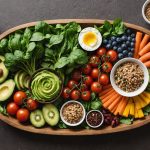Understanding Diabetes and Nutrition
In the realm of diabetes management, nutrition plays an essential role. With various types, such as Type 1, Type 2, and gestational diabetes, each has unique dietary needs that affect overall management.
Type 1 diabetes, where the pancreas produces little or no insulin, requires careful nutrition basics involving carb counting to maintain blood sugar levels. Type 2 diabetes, often linked to lifestyle factors, benefits from balanced nutrition to manage weight and increase insulin sensitivity. Gestational diabetes, occurring during pregnancy, necessitates a diet that safeguards both mother and child’s health.
Also to discover : Unlocking Muscle Recovery: The Surprising Benefits of Cryotherapy for Athletes
Balanced nutrition is pivotal in maintaining optimal blood sugar levels for diabetics. This involves a mix of carbohydrates, proteins, and fats without excessive sugar intake. The use of whole grains, lean proteins, and healthy fats, instead of processed sugars, enhances glucose control, contributing to effective diabetes management.
Misconceptions around diabetes diets often include complete avoidance of sugar or carbohydrates. The reality is moderation and balance are key, allowing individuals to enjoy diverse foods. Understanding diet basics wards off myths, empowering diabetics to create nutritious, satisfying meal plans. Furthermore, accurate information aids in dispelling misconceptions, encouraging informed dietary choices that enhance health outcomes.
Also read : Find your path with an online jungian analyst today
Key Nutritional Guidelines for a Diabetes-Friendly Diet
Navigating nutritional guidelines is crucial for those seeking to maintain healthy blood sugar levels. The essential nutrients for managing diabetes include carbohydrates, proteins, and fats, but their impact on blood sugar must be carefully monitored.
A pivotal element is the importance of fiber. Fiber slows the absorption of sugar, aiding in more stable blood sugar levels. Sources such as whole grains, legumes, vegetables, and fruits are ideal for incorporating fiber into one’s diet. Soluble fiber, in particular, is recommended as it can effectively reduce glucose absorption.
Healthy fats play a significant role in a diabetes-friendly regimen. Monounsaturated and polyunsaturated fats found in avocados, nuts, seeds, and olive oil can improve heart health without raising blood sugar. Conversely, saturated and trans fats should be limited to avoid increased insulin resistance.
Lean proteins are another integral part of dietary tips for managing diabetes. Proteins can help you feel full longer without spiking blood glucose. Lean meats like chicken, turkey, and plant-based options such as tofu and legumes are excellent choices.
By understanding and implementing these nutritional tips, individuals with diabetes can optimise their diet, thus better managing their condition and improving overall health outcomes.
Food Choices and Glycemic Index
Choosing foods based on their glycemic index (GI) is pivotal for maintaining balanced blood sugar levels. The glycemic index ranks carbohydrates from 0 to 100 based on how quickly they increase blood glucose levels after eating. Understanding this can aid in making healthier food choices, especially for those managing diabetes or seeking sustained energy levels.
Low Glycemic Index Foods
Low GI foods, which typically have a score of 55 or less, release glucose gradually into the bloodstream. Examples include most fruits and vegetables, whole grains, and legumes. Incorporating these foods into your diet can help in moderating blood sugar spikes, improving energy levels and potentially aiding in weight management.
High Glycemic Index Foods
In contrast, high GI foods score above 70 and cause rapid spikes in blood sugar. Examples include white bread, sugary cereals, and many processed snacks. Reducing the intake of these foods can be beneficial for those seeking to improve metabolic health.
How to Incorporate Low GI Foods into Meals
- Benefits: Emphasizing low GI foods helps in managing blood sugar more effectively.
- Identification: Be vigilant in identifying high GI foods to limit their presence in your diet.
- Meal Planning Tips: Include vegetables and whole grains in meals while choosing fruits over processed sweets. Such strategies can make food choices healthier and more sustainable.
Portion Control and Meal Planning
Effective management of diabetes hinges on portion control and strategic meal planning. Understanding portion sizes is crucial for maintaining balanced meals. By adhering to appropriate serving sizes, one can ensure a steady intake of nutrients without overloading on carbohydrates, a key practice for those managing diabetes.
Planning meals ahead of time aids in balancing blood sugar levels and can save time and stress. Start by identifying foods that are high in fibre, lean protein, and healthy fats. Incorporate these into a weekly plan that aligns with your dietary needs. Consider prepping ingredients in advance or cooking in larger batches for convenience.
For balanced meal planning, consider using templates. For breakfast, a portion might include a serving of oats with berries and a small handful of nuts. Lunch can consist of a green salad topped with grilled chicken and a vinaigrette. Dinner might feature a portion of grilled fish, a side of steamed vegetables, and quinoa. These templates ensure variety while maintaining control over food intake.
Devising a meal plan requires understanding individual nutritional needs and preferences, which helps promote healthier eating habits and supports effective diabetes management.
Recipe Ideas for Diabetes-Friendly Meals
When managing diabetes, it’s essential to enjoy delicious meals that also maintain balanced nutrition. Here are some creative diabetes-friendly recipes to inspire your meal planning.
Breakfast Recipes
Start your day with a nutritious punch by exploring various diabetes-friendly recipes. A quick and easy breakfast option could be a chia seed pudding. Simply combine chia seeds with almond milk, let it set overnight, and add fresh berries for natural sweetness. Alternatively, savour an avocado toast on whole-grain bread sprinkled with a pinch of flaxseeds for added fibre.
Lunch Recipes
Transform lunch into a balanced delight with diabetes-friendly meal ideas. Consider a healthy lunch idea for on-the-go, such as a whole grain wrap filled with lean chicken, mixed greens, and a slice of avocado. Or, create a wholesome salad using kale, quinoa, grilled tofu, and cherry tomatoes, seasoned with lemon vinaigrette to keep you energised throughout the day.
Dinner Recipes
Dinner signals the chance to unwind with wholesome dinner recipes. Consider grilled salmon served with steamed broccoli and sweet potato mash. This meal provides balanced nutrition with beneficial omega-3 fatty acids, vitamins, and fibre. Alternatively, try a lentil stew with spinach and diced carrots, simmered with aromatic herbs for a comforting, low-calorie dinner choice.
Tips for Managing Blood Sugar Levels
Maintaining stable blood sugar levels is essential for overall health. Employing best practices in blood sugar management can make a noticeable difference. Tracking blood sugar regularly provides valuable insights into how daily activities impact levels. Use a glucose meter consistently to record fluctuations throughout the day, ideally before meals and bedtime. This method helps in tailoring lifestyle changes and enhancing health outcomes.
Regular meal timing and consistency are crucial. Eating balanced meals at the same times daily helps maintain blood sugar stability. Opting for high-fibre, low-glycaemic foods can further support balanced levels. Consider incorporating whole grains, vegetables, and lean proteins into your diet, as these choices slow sugar absorption in the bloodstream, creating a steady energy supply.
Lifestyle changes can profoundly influence blood sugar management. Engage in regular physical activity, like brisk walking or cycling, at least 150 minutes per week. Exercise enhances insulin sensitivity, allowing cells to utilise blood sugar efficiently. Additionally, reducing stress through mindfulness or yoga can lower cortisol levels, preventing unnecessary blood sugar spikes.
Making small, informed adjustments to daily habits can significantly stabilise blood sugar levels and improve overall wellbeing. Remember, consistency is key, ensuring each change is sustainable and beneficial for long-term health.
Addressing Common Concerns and Misconceptions
Understanding diabetes diet concerns can be daunting, but myth-busting common misconceptions can alleviate many worries. One prevailing myth is that people with diabetes must avoid carbohydrates entirely. However, it is not about eliminating but managing carbohydrate intake using an individualized nutrition plan. Each person’s body responds differently, requiring a tailored approach to dietary needs.
Individualized nutrition plans consider factors such as age, activity level, and personal preferences. These plans balance carbohydrates alongside proteins and fats, ensuring adequate nutrient intake without unnecessary restrictions. By working with healthcare professionals, individuals can create a diet that is both healthy and enjoyable.
Another concern is the role of snacks. Many think snacking is off-limits. However, strategic snacking can maintain stable blood sugar levels and curb hunger. Snacks should include a mix of macronutrients to provide sustained energy and prevent spikes in blood sugar.
Common snack options might include:
- A small handful of nuts
- Greek yogurt with berries
- Whole-grain crackers with cheese
It’s crucial to consult with a nutritionist to find snack choices that fit an individual’s diabetes management plan. This approach empowers individuals with diabetes to enjoy a variety of foods while effectively managing their condition.
Expert Insights and Resources
Facing diabetes can feel overwhelming, but expert advice offers invaluable guidance. Quotes from nutritionists commonly emphasize the importance of a balanced diet. Understanding carbohydrates and their impact on blood sugar levels is often highlighted by educators. Similarly, regular consultation with diabetes experts ensures individuals manage the condition effectively and build a personalized approach to nutrition.
Seeking knowledge is crucial, and there is no shortage of resources. Highly recommended books include “The Diabetes Code” by Dr. Jason Fung, which delves into controlling blood sugar levels naturally. Websites like the American Diabetes Association offer curated content, while tools such as smartphone apps help track glucose levels, reinforcing discipline and consistency.
Feeling connected is equally important to managing diabetes. Support groups exist both online and offline where individuals can share experiences and tips. Platforms such as Beyond Type 1 connect people for mutual support and empathy. Engaging with community resources like workshops or seminars extends one’s knowledge and creates a supportive network.
Whether it’s through educators, technology, or community, diverse resources are available. Utilize these valuable insights and diabetes resources to maintain better health and improve quality of life.











